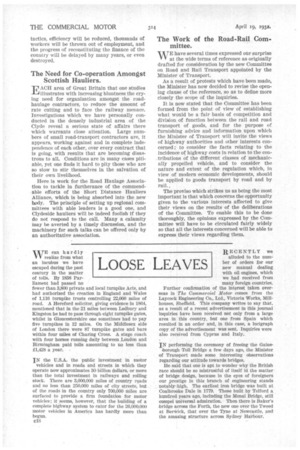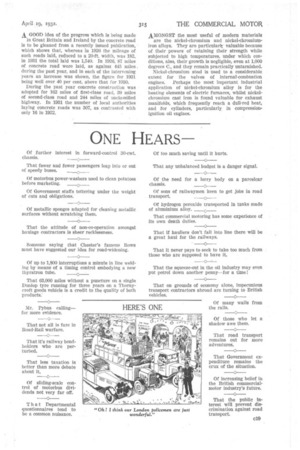LOOSE LEAVES
Page 40

Page 41

If you've noticed an error in this article please click here to report it so we can fix it.
WE can hardly realize from what an incubus we have escaped during the past century in the matter of tolls. By 1838 Parliament had passed no fewer than 3,800 private and local turnpike Acts, and had authorized the creation in England and Wales of 1,116 turnpike trusts controlling 22,000 miles of road. A Hereford solicitor, giving evidence in 1.864, mentioned that in the 21 miles between Ledbury and Kingston he had to pass through eight turnpike gates, whilst in Gloucestershire one sometimes had to pay five turnpikes in 12 miles. On the Middlesex side of London there were 87 turnpike gates and bars within four miles of Charing Cross. A stage coach with four horses running daily between London and Birmingham paid tolls amounting to no less than £1,428 a year. • IN the U.S.A. the public investment in motor vehicles and in roads and streets in which they operate now approximates 30 billion dollars, or more than the total investment in railways and rolling stock. There are 3,000,000 miles of country roads and no less than 250,000 miles of city streets, but of the roads in the country only 700,000 miles are surfaced to provide a firm foundation for motor vehicles; it seems, however, that the building of a complete highway system to eater for the 26,000,000 motor vehicles in America has hardly more than begun.
c18 RECENTLY we
alluded to the number of orders for our new manual dealing with oil engines, which we had received from many foreign countries. Further confirmation of the interest taken overseas in The Commercial if otor comes from the Laycock Engineering Co., Ltd., Victoria Works, Millhouses, Sheffield. This company writes to say that, as a result of a recent advertisement in this journal inquiries have been received not only from a large area in this country, but one from Spain which resulted in an order and, in this case, a lucigra.ph copy of the advertisement was sent. Inquiries were also received from Cyprus and Italy.
IN performing the ceremony of freeing the Gainsborough Toll Bridge a few days ago, the Minister of Transport made some interesting observations regarding our attitude towards bridges.
He said that one is apt to wonder why the British race should be so mistrustful of itself in the matter of bridge design, because in the eyes of foreigners our prestige in this branch of engineering stands notably high. The earliest iron bridge was built at Coalbrooke Dale in 1779. Those built by Telford a hundred years ago, including the Menai Bridge, still compel universal admiration. Then there is Baker's bridge across the Forth, the new one over the Tweed at Berwick, that over the Tyne at Newcastle, and the amazing structure across Sydney Harbour. A GOOD idea of the progress which is being made in Great Britain and Ireland by the concrete road is to be gleaned from a recently issued publication, which shows that, whereas in 1926 the mileage of such roads laid, reduced to a 20-ft. width, was 182, in 1931 the total laid was 1,540. In 1926, 87 miles of concrete road were laid, as against 445 miles during the past year, and in each of the intervening years an increase was shown, the figure for 1931 being well over 40 per cent, above that for 1930.
During the past year concrete construction was adopted for 162 miles of first-class road, 39 miles of second-class road and 244 miles of unclassified highway. In 1931 the number of local authorities laying concrete roads was 307, as contrasted with only 16 in 1922. AMONGST the most useful of modern materials are the nickel-chromium and nickel-chromiumiron alloys. They are particular tvaluable because of their powers of retaining their strength while subjected to high temperatures, under which conditions, also, their growth is negligible, even at 1,000 degrees C., and they remain practically untarnished.
Nickel-chromium steel is used to a considerable extent for the valves of internal-combustion engines. Perhaps the most important industrial application of nickel-chromium alloy is for the heating elements of electric furnaces, whilst nickelchromium cast iron is found valuable for exhaust manifolds, which frequently reach a dull-red heat, and for cylinders, particularly in compressionignition oil engines.












































































































